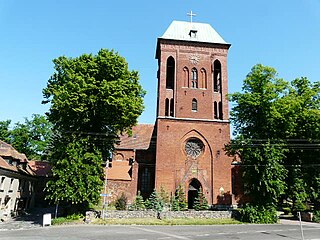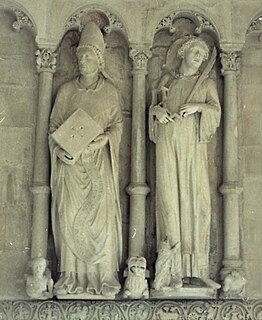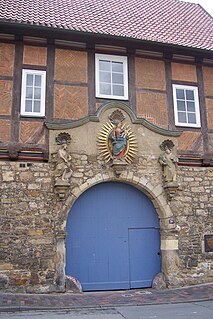
The Principality of Calenberg was a dynastic division of the Welf duchy of Brunswick-Lüneburg established in 1432. Calenberg was ruled by the House of Hanover from 1635 onwards; the princes received the ninth electoral dignity of the Holy Roman Empire in 1692. Their territory became the nucleus of the Electorate of Hanover, ruled in personal union with the Kingdom of Great Britain from 1714 onwards. The principality received its name from Calenberg Castle, a residence of the Brunswick dukes.

The Prince-Bishopric of Würzburg was an ecclesiastical principality of the Holy Roman Empire located in Lower Franconia, west of the Prince-Bishopric of Bamberg. Würzburg had been a diocese since 743. As established by the Concordat of 1448, bishops in Germany were chosen by the canons of the cathedral chapter and their election was later confirmed by the pope. Following a common practice in Germany, the prince-bishops of Würzburg were frequently elected to other ecclesiastical principalities as well. The last few prince-bishops resided at the Würzburg Residence, which is one of the grandest Baroque palaces in Europe.

The Prince-Bishopric of Minden was an ecclesiastical principality of the Holy Roman Empire. It was progressively secularized following the Protestant Reformation when it came under the rule of Protestant rulers, and by the Peace of Westphalia of 1648 given to Brandenburg as the Principality of Minden. It must not be confused with the Roman Catholic diocese of Minden, which was larger, and over which the prince-bishop exercised spiritual authority.

The Bishopric of Cammin was both a former Roman Catholic diocese in the Duchy of Pomerania from 1140 to 1544, and a secular territory of the Holy Roman Empire (Prince-Bishopric) in the Kolberg (Kołobrzeg) area from 1248 to 1650.

The Hildesheim Diocesan Feud or Great Diocesan Feud, sometimes referred to as a "chapter feud", was a conflict that broke out in 1519 between the Prince-Bishopric of Hildesheim and the principalities of Brunswick-Wolfenbüttel and Calenberg that were ruled by the House of Welf. Originally just a local conflict between the Hildesheim prince-bishop John IV of Saxe-Lauenburg and his own prince-bishopric's nobility (Stiftsadel), it developed into a major dispute between various Lower Saxon territorial princes. The cause was the attempt by Prince-Bishop John to redeem the pledged estates and their tax revenue from the nobles in his temporalities, the prince-bishopric. The diocesan feud ended with the Treaty of Quedlinburg in 1523.

Calenberg Castle was a medieval lowland castle in central Germany, near Schulenburg in the borough of Pattensen, 13 km west of the city of Hildesheim. It was built as a water castle in 1292 by the Welf duke, Otto the Strict, in der Leine river meadows between 2 branches of the Leine river on the southern part of the chalk marl hill of the Calenberg. At the start of the 16th century it was converted into a fort (Feste). In the 15th century, Fort Calenberg gave its name to the Welf Principality of Calenberg. Following the Thirty Years' War it lost its military importance and was slighted. Today it is a ruin with underground vaults that are surrounded by high ramparts.

The historic territory of Verden emerged from the Monarchs of the Frankish Diocese of Verden in the area of present-day central and northeastern Lower Saxony and existed as such until 1648. The territory managed by secular lords for the bishops was not identical with that of the bishopric, but was located within its boundaries and made up about a quarter of the diocesan area. The territory was referred to at the time as Stift Verden or Hochstift Verden, roughly equating to Prince-Bishopric of Verden. This territory described in local sources today incorrectly as Bistum Verden and, in 1648, was given the title Principality of Verden, sometimes referred to as the Duchy of Verden.

Henry III of Brunswick-Lüneburg was the ruling Prince-Bishop of Hildesheim from 1331 until his death.
Eric I, Count of Hoya (1370-1426) was a German nobleman. He was the ruling Count of Upper Hoya from 1377 until his death.
Francis of Brunswick-Wolfenbüttel was Bishop of Minden as Francis I from 1508 to 1529.

Hermann of Cilli, also known as Armand de Cilli, or Herniosus mit dem Bruche, was born in Cilli, the illegitimate son, although later legitimated, of Count Hermann II of Celje, of the family of the Counts of Cilli and Sanneck, whose family seat was in Celje Castle.

Ferdinand of Fürstenberg, contemporaneously also known as Ferdinandus liber baro de Furstenberg, was, as Ferdinand II, Prince Bishop of Paderborn from 1661 to 1683 and also Prince Bishop of Münster from 1678 to 1683, having been its coadjutor since 1667/68. He was brought almost complete restoration to the Bishopric of Paderborn after the devastation of the Thirty Years' War.
Eido I, also Ido, Eid or Ägidius, was the bishop of Meissen from 992 to 1015.

Reginhar was the 9th Bishop of Passau.

Dietrich of Altena-Isenberg, known as Dietrich III Bishop of Münster (1218–1226) was closely involved in the preparations for the construction of the St. Paul's Cathedral in Münster. On July 22, 1225, he laid the foundation stone for the new Dom Church, “Neubau iuxta formam templi Marienfeldensis aedificanda”

Engelbert of Altena-Isenberg was appointed Propst at St. George's Church in Cologne around 1220 and then Dompropst von Osnabrück in 1222. On September 4, 1223 Engelbertus, Osnabrugensis ecclesie maior prepositus he became Engelbert I bishop of the Prince-Bishopric of Osnabrück. and reigned during two periods, the first from 1224 - 1226 and the second from 1237 - 1250.

Hildesheim Charterhouse is a former Carthusian monastery or charterhouse in Hildesheim in Lower Saxony, Germany.













